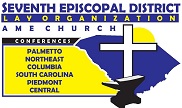Renaming a street in 2015
June 20, 2025
A Time Of Remembrance. https://youtu.be/PMJfm1LWF0g
To the Seventh District Lay Organization
Good morning to the members of the Seventh District Lay Organization.
I would like to express my gratitude to the President for allowing me the opportunity to share my experiences. It is important to reflect on the defining events of 2015, particularly from June 1 to September 19.
On June 1, 2015, we gathered at St. Peter’s AME Church on Sanders Ave in North Charleston, part of the Kingstree District, for an urgent meeting organized by the late Bishop Norris. The mission was clear: to unite the Methodist churches in South Carolina in demanding recognition that Black lives matter, especially in the wake of the Walter Scott shooting. I was present during this meeting.
Rev. Robert Kennedy, who is currently the pastor at St. Peter’s AME Church, was also in that position at that time, alongside Brother William Jenkins and Rev. Joseph Darby, who was then the Presiding Elder of the Beaufort District, among many others committed to this cause.
It’s worth noting that during this period, the late Brother Roger Cleckley served as the President of the Seventh District Lay Organization (SEDLO), and Brother Leroy Linen was the president of the South Carolina Conference Lay Organization. Although Cleckley and Linen were not present at the meeting, they should be acknowledged for their roles as lay leaders in the 7th District.
On June 17, 2015, members of Mother Emanuel AME Church invited a man with perverse intentions to join their Bible study. This situation echoes II Corinthians 11:14, which states, “No wonder, for even Satan disguises himself as an angel of light.” Any congregation that recognized this individual as a threat would not have permitted him entry.
The following day, June 18, Bishop Norris convened a meeting at Morris Brown AME Church in the Mt. Pleasant District and the Palmetto Conference. Although he could not attend due to health concerns following recent surgery, at least three or four AME Bishops, as well as members of the media and the conference, rallied in response to his call for unity. The Palmetto Annual Conference was the host of this meeting, but another meeting was held in the Seventh District.
The message was clear: the AME Church would not close its doors, and the harm caused by that individual would not hinder the progress of Black people.
Looking back, it is important to remember that in February 1962, the General Assembly passed a joint resolution to place a version of the Confederate Army of Northern Virginia’s battle flag atop the dome of the State House. This resolution coincided with the Civil War Centennial celebrations and demonstrated ongoing resistance to integration and equality.
On July 10, that symbol of hatred was finally taken down.
As Joseph stated in Genesis 50:20, “What the devil meant for evil, God turned to good.” The governor, who may had initially supported the flag’s display, ultimately changed their viewpoint after the tragedy and signed the bill to remove that oppressive symbol.
From September 19 to 26, during the 152nd Session of the South Carolina Annual Conference at Mother Emanuel AME Church in downtown Charleston, Bishop Richard F. Norris presided over this significant gathering. During this session, former Mayor Joseph P. Riley signed a proclamation renaming the area in front of the church as Mother Emanuel Way.
Later, when the Resolution Committee presented their report for approval, Bishop Norris asked the conference to vote on the resolution. I found this unacceptable and approached the chair to express my concerns. I believed the resolution did not adequately recognize the enduring efforts of Rev. Pinkney and misleadingly suggested he had made no plans for the conference, although he had initiated the request to host it at his church.
Recognizing the importance of this issue, Bishop Norris directed the committee to revise the report to accurately reflect Rev. Pinkney’s contributions. The revised report was subsequently approved by the Annual Conference.
I am thankful to God for allowing me to be present during this critical period in history and for the opportunity to document these significant events.
Brother Cleveland Frasier
